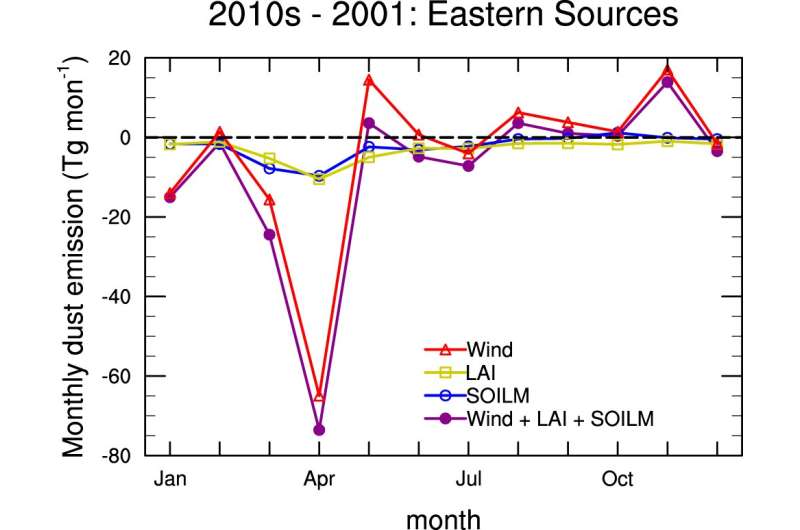Monthly dust emission change during 2010−2017 (2010s) relative to 2001. Changes due to individual factors (surface wind–“Wind”, vegetation cover–“LAI”, soil moisture–“SOILM”) and all the three factors together are depicted in red, yellow, blue, and deep magenta, respectively. The monthly changes are derived by calculating the dust emission change for each month from different model experiments (Table 1), as done in Fig. 1f. Note that summing the monthly changes for all the months yields the annual change shown in Fig. 1f. Credit: Nature Communications (2022). DOI: 10.1038/s41467-022-34823-3
Dust storms can be miles long and thousands of feet high. It may cause various environmental consequences including severe air pollution, land degradation, and damage to crop and livestock.
Dust entrained into the atmosphere serves as a major aerosol type, exerting effects on weather and climate system via aerosol-radiation-cloud interactions and delivering nutrients from continents to other continents and oceans.
Recently, a research team led by Dr. Wu Chenglai from the Institute of Atmospheric Physics of the Chinese Academy of Sciences investigated the factors driving the recent decline of East Asian dust activity.
The study was published in Nature Communications.
"It is important to understand the evolution of dust activity in the past and project its changes in the future," said Dr. Wu. "In fact, because of its natural origin, dust can serve as a mirror to understand the evolution of Earth System."
In recent decades, East Asian dust activity has decreased greatly. In particular, there is a strong decline of dust activity after a dusty period of 2000–2002. What are the reasons for the recent decline of dust activity in East Asia? How will dust activity change in the future?
"Dust emission depends on various factors including surface winds, soil conditions, vegetation cover, and human disturbances," said Prof. Lin Zhaohui, co-corresponding author of the study.
The essential part of the study was to use a physically-based dust emission model (DuEM) to reconstruct the dust emission flux from 2001 to 2017. Results showed that the model reproduced well the interannual variations and decreasing trends of dust activity in East Asia during 2001 to 2017.
Furthermore, the researchers conducted several sensitive experiments with one individual factor varying during 2001–2017 but other factors fixed to the level of the beginning year (i.e., year 2001). By comparing these experiments, they isolated the impacts of surface wind, soil moisture, and vegetation cover on the temporal variations of dust emission during 2001–2017.
"We find that the weakening of surface wind and the increase of vegetation cover and soil moisture all contribute to such dust emission reduction. The relative contributions of these three factors are 46%, 30%, and 24%, respectively," said Dr. Wu.
"Overall, changes in meteorological factors are the main drivers for recent decline in dust activity over East Asia," said Dr. Wu.
In fact, the weakening of surface wind can be ascribed to the reduced meridional temperature gradients due to the polar amplification of global warming. The weakening can also be partly explained by internal variability in the climate system such as the Pacific Decadal Oscillation (PDO). Increase of vegetation cover is closely related to the increase of CO2 concentrations and temperature as well as ecological restoration in China. Soil wetting may be mainly ascribed to the increase of precipitation in the source regions.
"We have got to take into account the evolution of all these relevant factors for projecting future dust change in this region," suggested Wu.
This study provides a reliable clue for future prediction of dust storm activity. The data of simulated dust emission is available at Science Data Bank repository.
More information: Chenglai Wu et al, Drivers of recent decline in dust activity over East Asia, Nature Communications (2022). DOI: 10.1038/s41467-022-34823-3
Journal information: Nature Communications
Provided by Chinese Academy of Sciences























